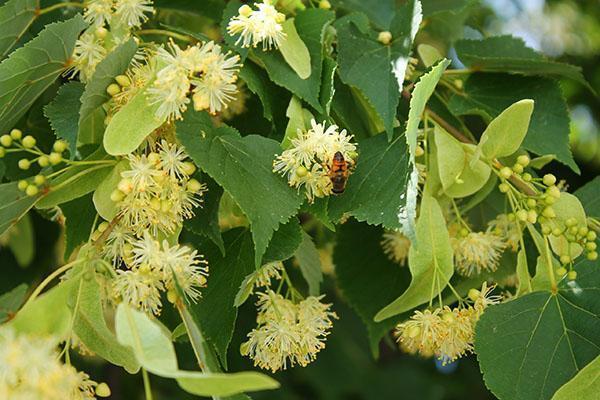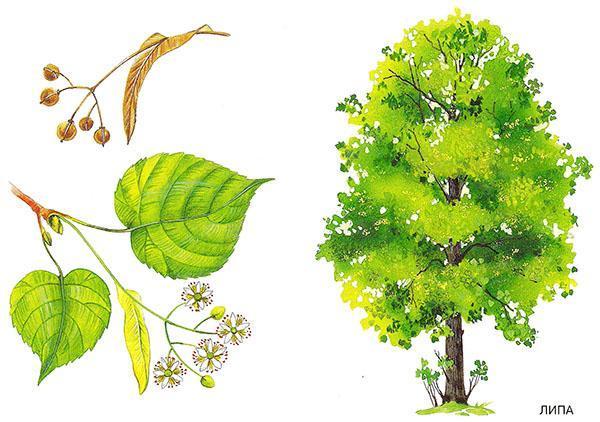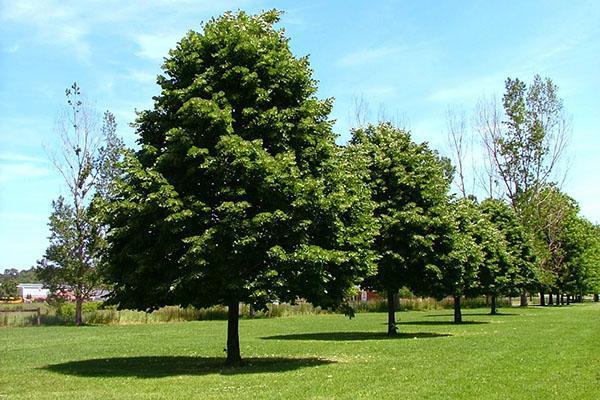Linden tree, unique in its qualities
 The linden tree in our squares and parks is found no less often than maples, birches and poplars. It is appreciated for its unpretentiousness, exceptional longevity, thick silky crown. The whole plant, from flowers to wood, is of great benefit. Inflorescences, bark, buds and bracts are valuable medicinal raw materials, not a single Russian steam room can do without a linden broom, eco-friendly dishes, bast, and burlap are made from durable bast.
The linden tree in our squares and parks is found no less often than maples, birches and poplars. It is appreciated for its unpretentiousness, exceptional longevity, thick silky crown. The whole plant, from flowers to wood, is of great benefit. Inflorescences, bark, buds and bracts are valuable medicinal raw materials, not a single Russian steam room can do without a linden broom, eco-friendly dishes, bast, and burlap are made from durable bast.
Right among the trees, this green beauty is considered a real treasure. Plus, it's easy to grow it yourself. In a word, the linden itself asks for under our windows. It remains to learn the intricacies of planting and caring for this amazing plant.
In the old days, seals were made of metal, which was expensive and difficult to process. Craftsmen began to forge them, carving blanks from the soft and pliable linden tree. Since then, a fake label has been firmly stuck to all fakes.
Description of the tree

Linden belongs to the woody plants of the Malvaceae family. Young leaves have stipules that fall off quickly. The open leaves are heart-shaped or oval, with jagged edges. The flowers are collected in umbrella-shaped inflorescences that extend from the bracts, unlike all others. After flowering, a nut-like fruit with seeds ripens.
In the open space, linden is formed as a sprawling single-stem or multi-stem tree. In shading, it looks more like a tall shrub. Life expectancy reaches 600 years.
Linden species
 The genus of the Linden tree describes about 45 species. In Eastern Europe, several varieties are widespread - heart-shaped linden (small-leaved or winter). It is distinguished by the bluish underside of the leaves, which have tufts of light brown hairs.
The genus of the Linden tree describes about 45 species. In Eastern Europe, several varieties are widespread - heart-shaped linden (small-leaved or winter). It is distinguished by the bluish underside of the leaves, which have tufts of light brown hairs.
 The second variety is large-leaved linden (flat-leaved or summer). She wakes up earlier in spring, has larger leaves without bluish bloom.
The second variety is large-leaved linden (flat-leaved or summer). She wakes up earlier in spring, has larger leaves without bluish bloom.
 In the Caucasus, in the Crimea and in the central European part of Russia, there is also a felt or silvery linden. Its strongly pubescent leaves feel like felt to the touch. This variety reaches 35 m in height, has a wide-pyramidal crown.
In the Caucasus, in the Crimea and in the central European part of Russia, there is also a felt or silvery linden. Its strongly pubescent leaves feel like felt to the touch. This variety reaches 35 m in height, has a wide-pyramidal crown.
 The Caucasian linden is distinguished by an even higher height, a spherical spreading crown and reddish-brown shoots.
The Caucasian linden is distinguished by an even higher height, a spherical spreading crown and reddish-brown shoots.
 Manchurian linden is a short tree with good winter hardiness. It is often multilateral. Widespread in the south of the Far East.
Manchurian linden is a short tree with good winter hardiness. It is often multilateral. Widespread in the south of the Far East.
Linden is easy to propagate by root shoots, stem layers, seeds and seedlings.
How to grow linden from seeds
 Seed propagation is the longest growing method. From the moment the seedlings turn into a young tree, at least 10 years will pass.
Seed propagation is the longest growing method. From the moment the seedlings turn into a young tree, at least 10 years will pass.
For good germination, linden seeds must be stratified. They are placed in a container with a damp substrate and placed in a cool dark place for 5-6 months, periodically moistening.
In spring, stratified seeds are sown in open ground. Seedlings are sheltered from wind and heavy rain, thinned out.At the beginning of summer, seedlings are fed with fertilizers containing nitrogen, in the second half of summer they switch to phosphorus-potassium mixtures.
For the winter, young sprouts need shelter. The next year, the plants are planted in a permanent place, which it is desirable to enclose.
Reproduction by layering
 To obtain a stem cut in the spring, before the foliage appears, the lower branches should be bent to the ground, laid in shallow grooves and dug in. In approximately the same way, cuttings of currants and gooseberries are obtained. After 1–2 years, the branches will sprout and a new plant will appear above the ground. It is cut off from the mother's root with a sharp shovel and transplanted to a permanent place.
To obtain a stem cut in the spring, before the foliage appears, the lower branches should be bent to the ground, laid in shallow grooves and dug in. In approximately the same way, cuttings of currants and gooseberries are obtained. After 1–2 years, the branches will sprout and a new plant will appear above the ground. It is cut off from the mother's root with a sharp shovel and transplanted to a permanent place.
Reproduction of linden by root layers is even easier. Mature plants produce abundant growth that is carefully removed from the parent tree and transplanted to a new location.
Linden is recommended to be grown in areas next to apiaries, as it is an excellent honey plant. Thanks to it, the productivity of bees and the quality of honey increase significantly.
How to properly plant a linden seedling
 Linden is undemanding to soils, but prefers light sandy loam with a high content of humus. Does not tolerate high groundwater levels.
Linden is undemanding to soils, but prefers light sandy loam with a high content of humus. Does not tolerate high groundwater levels.
When planting linden seedlings to create a hedge, you should know that they will reach full development only by the age of 25-40.
Young linden trees easily tolerate minor damage to the roots, but nevertheless, when planting, care should be taken to leave the earthen ball intact. When buying a seedling in a nursery, it is advisable to choose specimens with a closed root system.
The planting hole for a standard linden seedling should be at least half a meter in diameter and in depth. A drainage layer is poured onto the bottom - pebbles, crushed stone, expanded clay or broken brick. A layer of mature compost mixed with superphosphate is laid on top of the drainage at the rate of 50-60 g for each seedling. Then a seedling is placed in the pit and covered with soil with the following composition:
- 1 part of sod land;
- 2 parts of humus;
- 2 pieces of sand.
 Stakes are required to strengthen the seedlings. Along the edges of the planting pit, 2-3 pegs are driven in and tied to the trunk with soft loops.
Stakes are required to strengthen the seedlings. Along the edges of the planting pit, 2-3 pegs are driven in and tied to the trunk with soft loops.
The root collar is placed at ground level. If the soil in the pit settles slightly and the neck is slightly lower, this is not scary for the linden.
After planting, caring for a linden tree consists of abundant watering. Grown trees are fed twice a year. In spring, add to a bucket of water:
- 1 kg of manure;
- 20 g of carbamide;
- 25 g of ammonium nitrate.
Everything is mixed and poured into the trunk circle after watering with clean water. In autumn, add 20 g to a bucket of water nitroammophos.
Care and crown formation
 Only young plants need regular moisture. Adult specimens tolerate drought without problems. They are watered only in the driest period at the rate of 20 liters of water per 1 sq. m of the trunk circle.
Only young plants need regular moisture. Adult specimens tolerate drought without problems. They are watered only in the driest period at the rate of 20 liters of water per 1 sq. m of the trunk circle.
Loosening of the soil under a linden tree is carried out several times per season, while simultaneously removing weeds. Before winter, seedlings are mulched with leaf litter, sawdust, wood chips or peat 10–12 cm thick.
Linden is cut twice a year. Spring sanitary pruning is carried out before bud break. The tree is carefully examined and dry, broken and diseased branches are cut. In autumn formative pruning, the crowns growing inward and strongly thickening branches are removed.
At the very first pruning, the branches are shortened by no more than 1/3 part.
With such careful care, the linden tree will quickly turn into a luxurious spreading beauty. Rest in its shade will be serene, and the scent of flowers at noon in July will refresh and bring back the best memories.